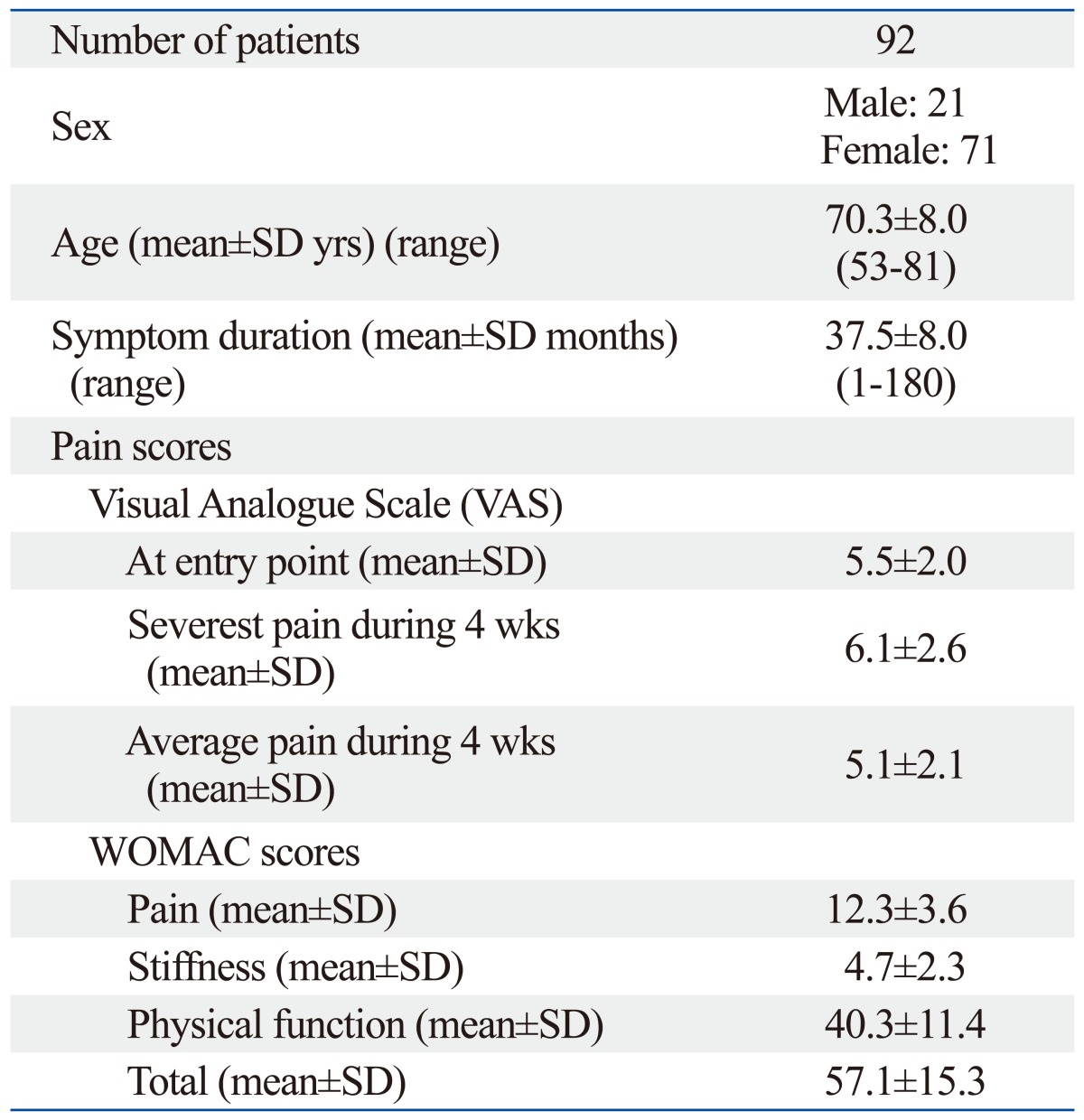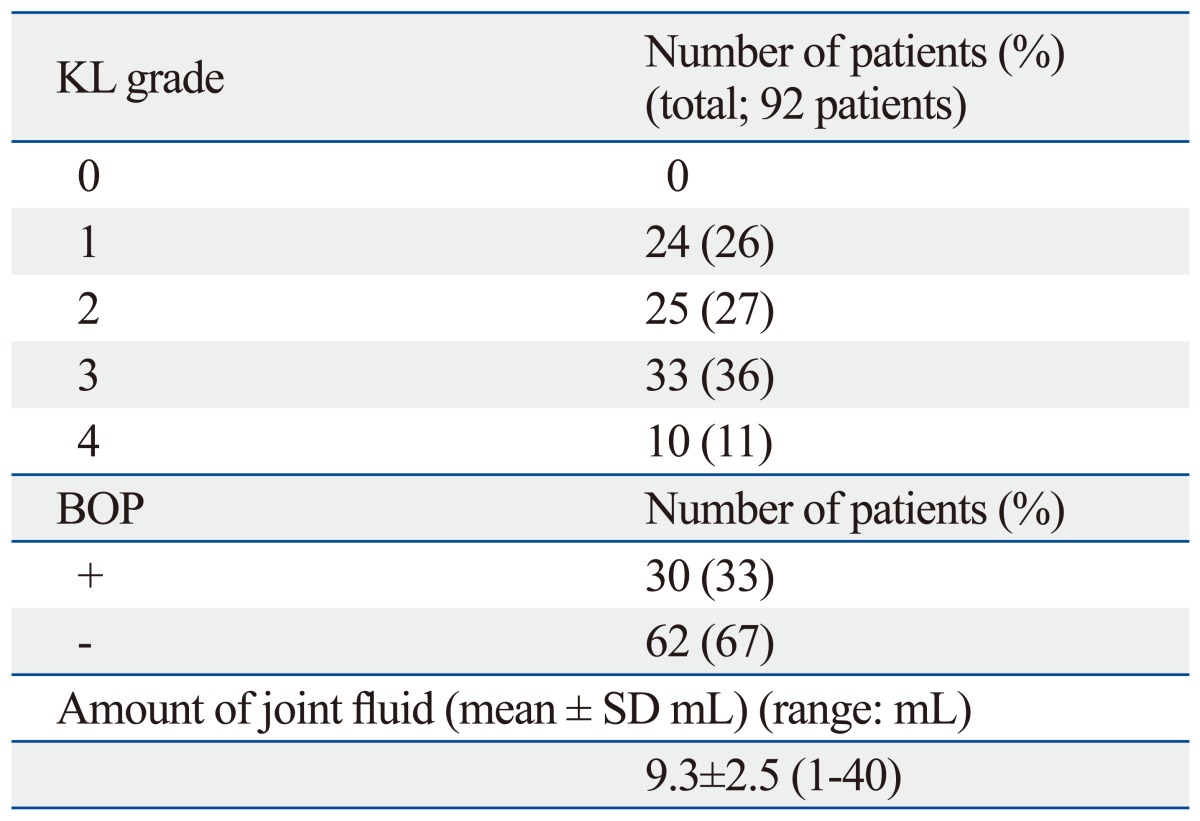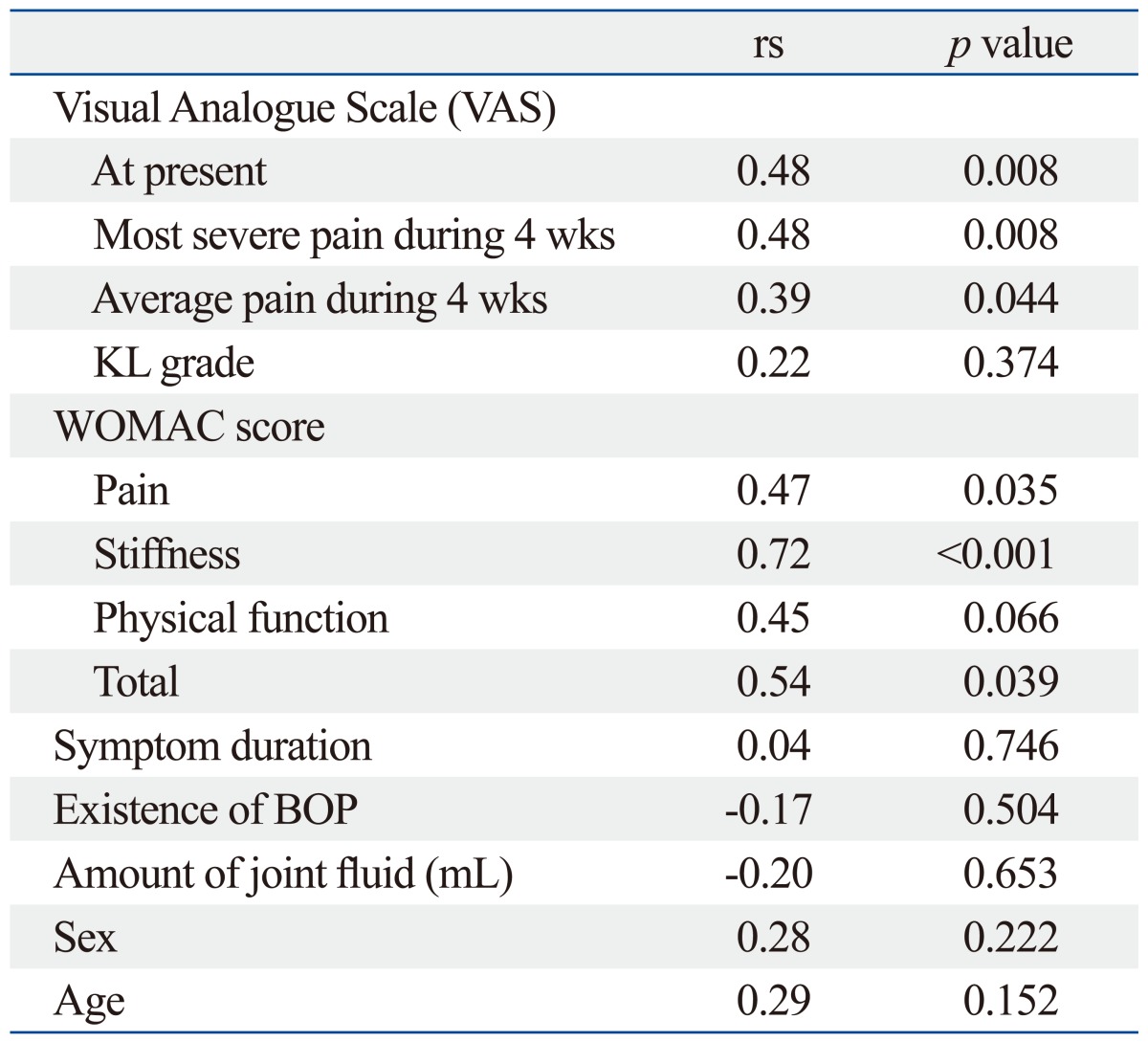Abstract
Purpose
Pain from osteoarthritis (OA) is generally classified as nociceptive (inflammatory). Animal models of knee OA have shown that sensory nerve fibers innervating the knee are significantly damaged with destruction of subchondral bone junction, and induce neuropathic pain (NP). Our objective was to examine NP in the knees of OA patients using painDETECT (an NP questionnaire) and to evaluate the relationship between NP, pain intensity, and stage of OA.
Materials and Methods
Ninety-two knee OA patients were evaluated in this study. Pain scores using Visual Analogue Scales (VAS), Western Ontario and McMaster Universities Osteoarthritis Index (WOMAC), painDETECT, duration of symptoms, severity of OA using the Kellgren-Lawrence (KL) system, and amount of joint fluid were evaluated and compared using a Spearman's correlation coefficient by rank test.
Results
Our study identified at least 5.4% of our knee OA patients as likely to have NP and 15.2% as possibly having NP. The painDETECT score was significantly correlated with the VAS and WOMAC pain severity. Compared with the painDETECT score, there was a tendency for positive correlation with the KL grade, and tendency for negative correlation with the existence and amount of joint fluid, but these correlations were not significant.
Conclusion
PainDETECT scores classified 5.4% of pain from knee OA as NP. NP tended to be seen in patients with less joint fluid and increased KL grade, both of which corresponded to late stages of OA. It is important to consider the existence of NP in the treatment of knee OA pain.
Keywords: Knee, osteoarthritis, neuropathic pain, nociceptive pain
INTRODUCTION
Knee osteoarthritis (OA) is a common and progressive joint disease. With an estimated incidence rate of 240 per 100000 person-years, it is a major public health problem in the US and often results in early retirement and joint replacement.1
Chronic pain is classified into nociceptive (inflammatory) pain and neuropathic pain (NP). Nociceptive pain, such as that in rheumatoid arthritis, results from continuously stimulating nociceptors through chronic inflammation. NP is generated from damage or dysfunction to the nervous system. Major causes of NP include diabetes, lumbar or cervical radiculopathies, and spinal cord injury.2,3 Knee OA is generally classified as nociceptive (inflammatory) pain.
It has been reported that intra-articular injection of mono-iodoacetate into the femorotibial joint space in mice and rats induces a linear pathology with similarities to OA, and this model is now widely used for investigating the pathogenesis of knee pain.4 In the early phase of rat OA, the level of inflammatory neuropeptides in sensory nerves innervating the knee increases.5 On the other hand, as subchondral bone is densely innervated, subchondral bone pathology may cause neuropathy after destruction of chondral structure in the late phases of OA. In the late phase of OA in rat models, markers of nerve injury in sensory nerves innervating the knee are significantly increased compared with controls.6 Understanding whether nerve damage or neuropathy underpins the lack of pharmacological sensitivity to celecoxib or diclofenac, but not morphine observed at later time points would clarify the origin of pain.7,8 These observations suggest that the pain of knee OA is both nociceptive pain and NP. However, the origin of pain is generally unknown in clinical cases.
For measurement of NP in patients with other chronic pain conditions the PainDETECT score, the Leeds Assessment of Neuropathic Symptoms and Signs pain scale with a self-report version (LANSS), the Douleur Neuropathique with 4 questions (DN4), ID Pain, and the Neuropathic Pain Questionnaire (NPQ) have been developed.9-13 Compared with expert physician diagnosis of NP versus non-NP, the sensitivity, specificity, and positive predictive values of these measures ranges from 66.6% to 85%, 74% to 90%, and 71.4% to 86%, respectively.14 Only one report has described the relationship between OA pain and NP in patients with OA of the knee. Hochman, et al.15 previously reported that 34% of patients with OA of the knee had pain with an NP component; however, the relationships among NP, pain intensity, and stage of OA have not been examined.
Our hypothesis is that there is an NP component in knee OA pain, and that the NP is particularly seen in late phases of OA related to the severity of pain, severity of OA using radiographic evaluation, and reduced amounts of joint fluid. The purpose of our current study was to examine the extent of NP in the knees of OA patients using painDETECT, and to evaluate the relationship between NP and stage of OA.
MATERIALS AND METHODS
The ethics committee of our institution approved the protocol for the human procedures used in this study. Furthermore, the protocol and publication of the study were approved by our institutional review board and informed consent was obtained from each of the participants.
The patients who participated in this study were selected from outpatients who attended our hospital for knee pain. These 92 patients were selected from 112 knee pain patients who matched the following criteria. All patients had knee pain for more than 1 month. Inclusion criteria were the observation of the existence of OA of the knee joint on examination of an anterior-posterior X-ray image. Patients who had history of knee surgery, infection, and rheumatoid arthritis were excluded from this study. Ultimately, 20 patients were excluded, and 92 patients having OA of the knee joint were evaluated. The patients completed a self-administered questionnaire on sociodemographic factors (age and gender) and duration of knee symptoms. The background of the subjects is summarized in Table 1.
Table 1.
Demographic Characteristics
WOMAC, western ontario and McMaster universities osteoarthritis index.
Pain scores
Various screening tools have been developed to identify NP, including LANSS, DN4, NPQ, painDETECT, and ID Pain.9-13 These tools have been developed for evaluation of NP such as nerve injury, radicular pain, and diabetic neuropathy. Hochman, et al.15 selected a list of NP descriptors from these 5 validated questionnaires and used them for knee OA pain. Five items were commonly identified to distinguish nociceptive pain from NP in people with other chronic pain conditions. They reported that 34% of knee OA patients described their pain using quality descriptors suggestive of NP, and concluded that the 5 items are reliable indicators.15 Bennett, et al.14 reviewed the strengths and weakness of these 5 validated questionnaires and reported that painDETECT did not require a clinical examination, and showed a slightly higher sensitivity and specificity in comparison with the other tools. Thus, in the current study, we selected painDETECT for this advantage.
All patients completed the Visual Analogue Scale (VAS), Western Ontario and McMaster Universities Osteoarthritis Index (WOMAC), and painDETECT screening.9,16 WOMAC consists of subsections for pain, stiffness, and physical function. PainDETECT is a patient-based questionnaire consisting of seven weighted sensory descriptor items and two items relating to the spatial (radiating) and temporal characteristics of the patient's pain pattern. The painDETECT score was distributed from 0 to 38. Patients were divided into three groups: neuropathic pain is likely (score ≥19), possible (score ≥13 to ≤18), and unlikely (score ≤12). VAS was evaluated at 3 time points. VAS at entry point, of severest pain during 4 weeks, and of average pain during 4 weeks were evaluated for all patients.
Radiographic evaluation
Anterior-posterior view of X-ray examination was performed in all patients. We used the Kellgren-Lawrence (KL) severity classification system, which is a validated method of classifying individual joints into one of five grades, with 0 representing normal and 4 being the most severe radiographic disease.17 Evaluation was blinded and performed by 5 observers. If at least 3 of the observers concurred, the grading score was used to define KL grade.
Evaluation of knee joint fluid
Ballottment of the patella (BOP) was examined for all patients. If the BOP sign was positive, needle puncture into the knee was performed in all positive patients and the amount of joint fluid was evaluated.
Statistical Analysis
Data were compared using a Spearman's correlation coefficient by rank test. p<0.05 was considered statistically significant.
RESULTS
Table 1 shows demographic characteristics of patients. Ninety-two patients (71 female, 21 male) with a mean age of 70.3 years were included in the study during the entire period. Average duration of symptoms was 37.5 months. The patients suffered from knee pain originating from OA for at least 1 month. Pain at entry point using VAS was 5.5 and total WOMAC score was 57.1.
Table 2 shows the painDETECT score and indicates likely NP (score ≥19), possible NP (score ≥13 to ≤18), and unlikely NP (score ≤12). Within this study population, 5 (5.4%) were classified as likely NP, 14 (15.2%) as possible NP, and 73 (79.3%) as unlikely NP.
Table 2.
PainDETECT Score
Neuropathic pain is likely (score ≥19), possible (score ≥13 to ≤18), and unlikely (score ≤12).
Table 3 evaluates KL grade, BOP, and amount of joint fluid of knee. There was no patient with KL0 and all patients were distributed from KL1 to KL4. The proportion of patients with BOP was 33% of all patients and average amount of joint fluid was 9.3±2.5 mL.
Table 3.
X-ray Evaluation, BOP, and Amount of Joint Fluid
BOP, ballottment of the patella; KL, Kellgren-Lawrence.
Table 4 shows the correlation between the painDETECT score and each factor. A strongly significant correlation was seen with the WOMAC stiffness score (rs=0.72, p<0.001), and a moderately significant correlation was seen with the VAS scores (rs=0.39, p=0.044), WOMAC pain (rs=0.47, p=0.035) and total scores (rs=0.54, p=0.039). There was a tendency for positive correlation between the painDETECT score and KL grade (rs=0.22, p=0.374), and tendency for negative correlation between the painDETECT score, existence of BOP (rs=-0.17, p=0.504), and amount of joint fluid (rs=-0.20, p=0.653). However, there was no significant positive or negative correlation between painDETECT score, KL grade (p=0.374), existence of BOP (p=0.504), or amount of joint fluid (p=0.653).
Table 4.
PainDETECT and Correlation Coefficients
WOMAC, western ontario and McMaster universities osteoarthritis index; BOP, ballottment of the patella.
There was no significant correlation between the painDETECT score and duration of symptoms (p=0.746), sex (p=0.22), or age (p=0.15).
DISCUSSION
OA has a high prevalence in the elderly population and is a major cause of disability within this group.18 Generally, the origin of OA pain has been considered to be nociceptive, but our study identified at least 5.4% of our knee OA patients as likely to have NP and 15.2% as possibly having NP. painDETECT scores were correlated with VAS and WOMAC assessments of pain severity. Therefore, some patients with severe pain and disability from the pain may have a NP component in their knee OA pain.
Some authors have reported that joint pain arises mainly from free nerve endings that exist in the capsule or in the synovium,19-21 whereas others have reported innervation of the osteochondral junction in human knee OA samples and indicated a possible contribution of the subchondral area to OA knee pain.22,23 Regarding the mechanism of NP in knee OA, it is highly possible that NP occurs in association with damage to nerves innervating subchondral bone because of its weight-bearing surface in late stage OA. In early phases, synovitis produces joint fluid and stimulates free nerve endings in synovium. On the other hand, a decrease in the amount of joint fluid and destruction of the osteochondral junction may induce injury to the nerve endings in this area in late phases of OA. The current study showed the possibility of NP pathogenesis in OA pain; however, this was not clear because the correlations were not significant. There was a tendency for positive correlation between painDETECT score and the KL grade, and tendency for negative correlation between the painDETECT score and the amount of joint fluid. Further study using a larger population is probably needed to clarify this.
Another mechanism has been postulated for NP in OA. Approximately 60-80% of OA patients achieve pain relief after local anesthetic treatment or surgical replacement of the affected joint, indicating peripheral mechanisms driving the pain, although central mechanisms are also thought to play a role in some patients and dysfunction of diffuse noxious inhibitory controls has been described.24-26 These central mechanisms may overlap with those in other pain states such as neuropathy.
There are several limitations of this study. The reliability of painDETECT for NP in knee OA has not been fully evaluated, therefore, further study is needed to clarify this.
In conclusion, the PainDETECT scores for pain from knee OA revealed that 5.4% are likely NP, and 15.2% are possible NP. NP tended to be seen in patients with less joint fluid and a KL grade that correspond to late stages of OA. It is important to be aware of consider the existence of NP in the treatment of knee OA pain.
Footnotes
The authors have no financial conflicts of interest.
References
- 1.Arthritis types: overview. Centers for Disease Control and Prevention. National Center for Chronic Disease Prevention and Health Promotion. 2008. http://www.cdc.gov/arthritis/osteoarthritis.htm.
- 2.Daousi C, MacFarlane IA, Woodward A, Nurmikko TJ, Bundred PE, Benbow SJ. Chronic painful peripheral neuropathy in an urban community: a controlled comparison of people with and without diabetes. Diabet Med. 2004;21:976–982. doi: 10.1111/j.1464-5491.2004.01271.x. [DOI] [PubMed] [Google Scholar]
- 3.Siddall PJ, McClelland JM, Rutkowski SB, Cousins MJ. A longitudinal study of the prevalence and characteristics of pain in the first 5 years following spinal cord injury. Pain. 2003;103:249–257. doi: 10.1016/S0304-3959(02)00452-9. [DOI] [PubMed] [Google Scholar]
- 4.van der Kraan PM, Vitters EL, van de Putte LB, van den Berg WB. Development of osteoarthritic lesions in mice by "metabolic" and "mechanical" alterations in the knee joints. Am J Pathol. 1989;135:1001–1014. [PMC free article] [PubMed] [Google Scholar]
- 5.Ochiai N, Ohtori S, Sasho T, Nakagawa K, Takahashi K, Takahashi N, et al. Extracorporeal shock wave therapy improves motor dysfunction and pain originating from knee osteoarthritis in rats. Osteoarthritis Cartilage. 2007;15:1093–1096. doi: 10.1016/j.joca.2007.03.011. [DOI] [PubMed] [Google Scholar]
- 6.Ivanavicius SP, Ball AD, Heapy CG, Westwood FR, Murray F, Read SJ. Structural pathology in a rodent model of osteoarthritis is associated with neuropathic pain: increased expression of ATF-3 and pharmacological characterisation. Pain. 2007;128:272–282. doi: 10.1016/j.pain.2006.12.022. [DOI] [PubMed] [Google Scholar]
- 7.Fernihough J, Gentry C, Malcangio M, Fox A, Rediske J, Pellas T, et al. Pain related behaviour in two models of osteoarthritis in the rat knee. Pain. 2004;112:83–93. doi: 10.1016/j.pain.2004.08.004. [DOI] [PubMed] [Google Scholar]
- 8.Pomonis JD, Boulet JM, Gottshall SL, Phillips S, Sellers R, Bunton T, et al. Development and pharmacological characterization of a rat model of osteoarthritis pain. Pain. 2005;114:339–346. doi: 10.1016/j.pain.2004.11.008. [DOI] [PubMed] [Google Scholar]
- 9.Freynhagen R, Baron R, Gockel U, Tölle TR. painDETECT: a new screening questionnaire to identify neuropathic components in patients with back pain. Curr Med Res Opin. 2006;22:1911–1920. doi: 10.1185/030079906X132488. [DOI] [PubMed] [Google Scholar]
- 10.Bennett M. The LANSS Pain Scale: the Leeds assessment of neuropathic symptoms and signs. Pain. 2001;92:147–157. doi: 10.1016/s0304-3959(00)00482-6. [DOI] [PubMed] [Google Scholar]
- 11.Bouhassira D, Attal N, Alchaar H, Boureau F, Brochet B, Bruxelle J, et al. Comparison of pain syndromes associated with nervous or somatic lesions and development of a new neuropathic pain diagnostic questionnaire (DN4) Pain. 2005;114:29–36. doi: 10.1016/j.pain.2004.12.010. [DOI] [PubMed] [Google Scholar]
- 12.Portenoy R. Development and testing of a neuropathic pain screening questionnaire: ID Pain. Curr Med Res Opin. 2006;22:1555–1565. doi: 10.1185/030079906X115702. [DOI] [PubMed] [Google Scholar]
- 13.Krause SJ, Backonja MM. Development of a neuropathic pain questionnaire. Clin J Pain. 2003;19:306–314. doi: 10.1097/00002508-200309000-00004. [DOI] [PubMed] [Google Scholar]
- 14.Bennett MI, Attal N, Backonja MM, Baron R, Bouhassira D, Freynhagen R, et al. Using screening tools to identify neuropathic pain. Pain. 2007;127:199–203. doi: 10.1016/j.pain.2006.10.034. [DOI] [PubMed] [Google Scholar]
- 15.Hochman JR, French MR, Bermingham SL, Hawker GA. The nerve of osteoarthritis pain. Arthritis Care Res (Hoboken) 2010;62:1019–1023. doi: 10.1002/acr.20142. [DOI] [PubMed] [Google Scholar]
- 16.Bellamy N, Buchanan WW, Goldsmith CH, Campbell J, Stitt LW. Validation study of WOMAC: a health status instrument for measuring clinically important patient relevant outcomes to antirheumatic drug therapy in patients with osteoarthritis of the hip or knee. J Rheumatol. 1988;15:1833–1840. [PubMed] [Google Scholar]
- 17.Kellgren JH, Lawrence JS. Radiological assessment of osteo-arthrosis. Ann Rheum Dis. 1957;16:494–502. doi: 10.1136/ard.16.4.494. [DOI] [PMC free article] [PubMed] [Google Scholar]
- 18.Mäntyselkä P, Kumpusalo E, Ahonen R, Kumpusalo A, Kauhanen J, Viinamäki H, et al. Pain as a reason to visit the doctor: a study in Finnish primary health care. Pain. 2001;89:175–180. doi: 10.1016/s0304-3959(00)00361-4. [DOI] [PubMed] [Google Scholar]
- 19.Grönblad M, Korkala O, Liesi P, Karaharju E. Innervation of synovial membrane and meniscus. Acta Orthop Scand. 1985;56:484–486. doi: 10.3109/17453678508993040. [DOI] [PubMed] [Google Scholar]
- 20.Fortier LA, Nixon AJ. Distributional changes in substance P nociceptive fiber patterns in naturally osteoarthritic articulations. J Rheumatol. 1997;24:524–530. [PubMed] [Google Scholar]
- 21.Saito T, Koshino T. Distribution of neuropeptides in synovium of the knee with osteoarthritis. Clin Orthop Relat Res. 2000:172–182. doi: 10.1097/00003086-200007000-00024. [DOI] [PubMed] [Google Scholar]
- 22.Suri S, Gill SE, Massena de Camin S, Wilson D, McWilliams DF, Walsh DA. Neurovascular invasion at the osteochondral junction and in osteophytes in osteoarthritis. Ann Rheum Dis. 2007;66:1423–1428. doi: 10.1136/ard.2006.063354. [DOI] [PMC free article] [PubMed] [Google Scholar]
- 23.Ogino S, Sasho T, Nakagawa K, Suzuki M, Yamaguchi S, Higashi M, et al. Detection of pain-related molecules in the subchondral bone of osteoarthritic knees. Clin Rheumatol. 2009;28:1395–1402. doi: 10.1007/s10067-009-1258-0. [DOI] [PubMed] [Google Scholar]
- 24.Creamer P, Hunt M, Dieppe P. Pain mechanisms in osteoarthritis of the knee: effect of intraarticular anesthetic. J Rheumatol. 1996;23:1031–1036. [PubMed] [Google Scholar]
- 25.Ethgen O, Bruyère O, Richy F, Dardennes C, Reginster JY. Health-related quality of life in total hip and total knee arthroplasty. A qualitative and systematic review of the literature. J Bone Joint Surg Am. 2004;86-A:963–974. doi: 10.2106/00004623-200405000-00012. [DOI] [PubMed] [Google Scholar]
- 26.Kosek E, Ordeberg G. Lack of pressure pain modulation by heterotopic noxious conditioning stimulation in patients with painful osteoarthritis before, but not following, surgical pain relief. Pain. 2000;88:69–78. doi: 10.1016/S0304-3959(00)00310-9. [DOI] [PubMed] [Google Scholar]






